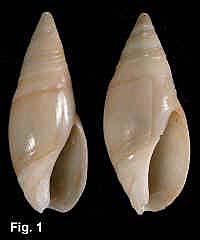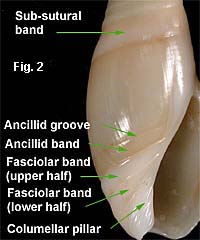

|
Amalda
petterdi
(Tate, 1893))
Description: Shell varies from slender
to moderately broad, aperture about one-half of total shell length.
Spire calloused, callus terminating in front of the aperture;
suture covered by callus. Spire
whorls vary from weakly to strongly spirally ribbed, 3-9 ribs per whorl,
ribs ending at aperture. Body
whorl with calloused subsutural band, edged by a weak groove.
Non-calloused part of body whorl with microscopic axial and
spiral striae. Columellar
pillar with 5-6 plaits; fasciolar band with central ridge, upper and
lower halves flat and smooth; ancillid band well defined, bordered above
by the ancillid groove and below by the strong, raised edge of the
fasciolar band. Non-calloused
areas fawn; spire and subsutural band white; fasciolar band and pillar
area white. Operculum brown,
corneous.
Size:Up
to 28 mm in length.
Distribution: Endemic to
Australia
;
Clarence
River
, NSW, to
Great Australian Bight
,
South Australia
.
Habitat:
Known from 66-457 metres. Common.
Comparison:
This is a deep water species, never taken as a beach shell.
It has no spiral brown bands, and has a weakly to strongly spirally ridged spire.
Synonyms: This species has been known as Amalda
fusiformis (Petterd, 1886), but that name was preoccupied and was replaced by Tate in 1893.
Iredale described a shell from off Merimbula, NSW, as
Alocospira fusiformis
gaza
Iredale, 1924, on the basis that it was
"peculiarly elongate". With the range of
material now available it is apparent that the species varies
in width, and Iredale’s specimen falls within the range of
variation. Examination of the types of Amalda
lanceolata Ninomiya, 1991 shows this to be another synonym (new
synonym).
Remarks:
This is the most common of the deep water species in NSW.
It is quite variable in shape, from tall and slender to short and
squat, but consistent in colour, always without brown bands.
Figs 1,2: Brisbane Water, Broken Bay, NSW (C.424277, both
specimens)
|